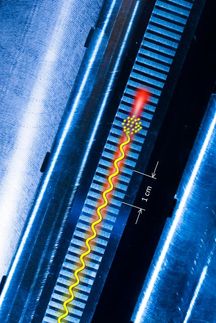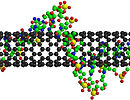Breakthrough in nanotechnology by uncovering conductive property of carbon-based molecules
Newfound ability of organic molecules to conduct electricity opens door to smaller, cheaper and more powerful technologies
University of Pittsburgh researchers have discovered that certain organic - or carbon-based - molecules exhibit the properties of atoms under certain circumstances and, in turn, conduct electricity as well as metal. Detailed in Science, the finding is a breakthrough in developing nanotechnology that provides a new strategy for designing electronic materials, including inexpensive and multifunctional organic conductors that have long been considered the key to smaller, cheaper, and faster technologies.
The Pitt team found that fullerenes can old and transfer an electrical charge much like the most highly conductive atoms, explained project head Hrvoje Petek, a professor of physics and chemistry in Pitt's School of Arts and Sciences and codirector of Pitt's Petersen Institute for NanoScience and Engineering. The research was performed by Pitt post-doctoral associates Min Feng and Jin Zhao.
When an electron was introduced into a fullerene molecule, the shape of the electron distribution mimicked that of a hydrogen atom or an atom from the alkali metal group, which includes lithium, sodium, and potassium. Moreover, when two fullerenes were placed next to each other on a copper surface, they showed the electron distribution of their chemical bond and appeared as H2, a hydrogen molecule. The assembly exhibited metal-like conductivity when the team extended it to a wire 1-molecule-wide.
"Our work provides a new perspective on what determines the electronic properties of materials," Petek said. "The realization that hollow molecules can have metal-like conductivity opens the way to develop novel materials with electronic and chemical properties that can be tailored by shape and size."
Although the team worked with fullerenes, the team's results apply to all hollow molecules, Petek added, including carbon nanotubes - rolled, 1-atom-thick sheets of graphite 100,000 times smaller than a human hair.
The team's research shows promise for the future of electronics based on molecular conductors. These molecule-based devices surpass the semiconductor and metal conductors of today in terms of lower cost, flexibility, and the ability to meld the speed and power of optics and electronics. Plus, unlike such inorganic conductors as silicon, molecule-based electronics can be miniaturized to a 1-dimensional scale (1-molecule-wide), which may enable them to conduct electricity with minimal loss and thus improve the performance of an electronic device.
Traditionally, the problem has been that organic conductors have not conducted electrical current very well, Petek said. The Pitt team's discovery could enable scientists to finally overcome that problem, he added.
"Metal-like behavior in a molecular material-as we have found-is highly surprising and desirable in the emerging field of molecular electronics," he said.
"Our work is a unique example of how nanoscale materials can be used as atom-sized building blocks for molecular materials that could replace silicon and copper in electronic devices, luminescent displays, photovoltaic cells, and other technologies."
Most read news
Topics
Organizations
Other news from the department science

Get the analytics and lab tech industry in your inbox
By submitting this form you agree that LUMITOS AG will send you the newsletter(s) selected above by email. Your data will not be passed on to third parties. Your data will be stored and processed in accordance with our data protection regulations. LUMITOS may contact you by email for the purpose of advertising or market and opinion surveys. You can revoke your consent at any time without giving reasons to LUMITOS AG, Ernst-Augustin-Str. 2, 12489 Berlin, Germany or by e-mail at revoke@lumitos.com with effect for the future. In addition, each email contains a link to unsubscribe from the corresponding newsletter.

























































